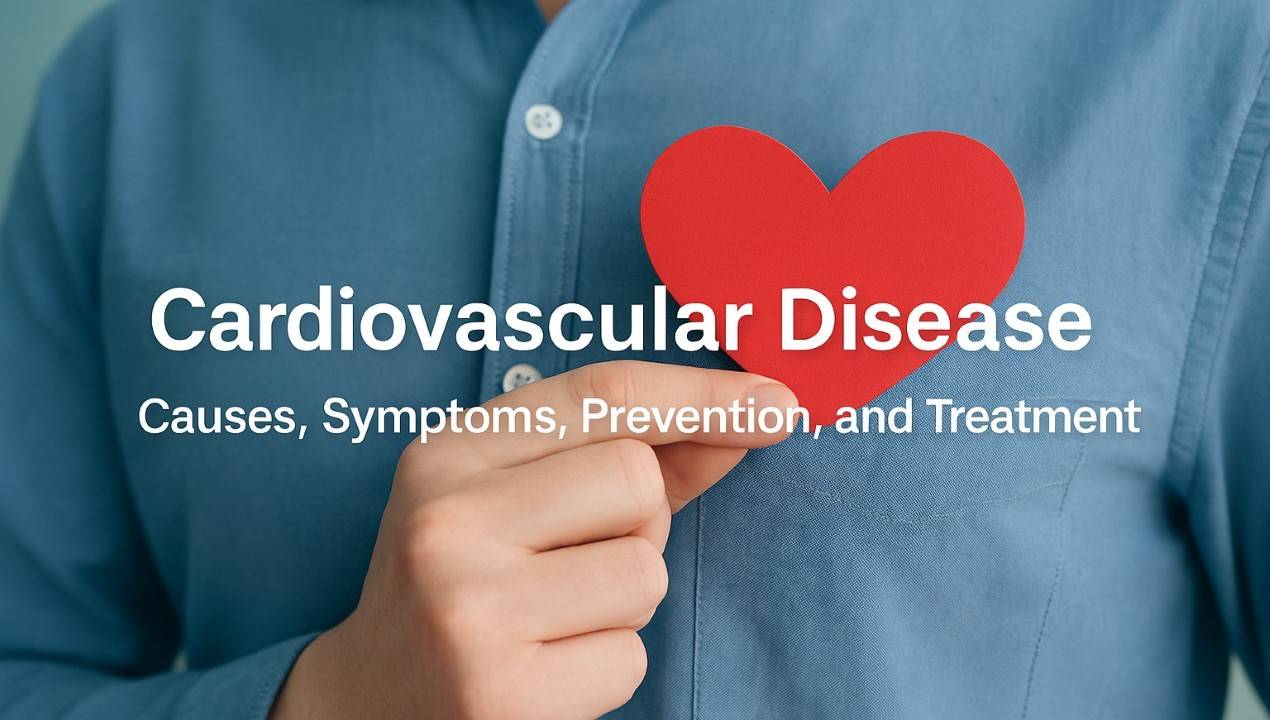Cardiovascular disease (CVD) is one of the leading causes of death worldwide, affecting millions of people every year. But here’s the good news: most types of CVD are preventable or manageable if caught early and treated properly.
In this guide, we’ll break down everything you need to know — from the different types of cardiovascular disease to risk factors, warning signs, and ways to protect your heart for life.
What Is Cardiovascular Disease?
Encompasses heart and vessel disorders. The term covers many conditions, but they all have one thing in common — they disrupt the normal flow of blood through the body, which can lead to serious complications like a heart attack or stroke.
Some of the most common types include:
- Coronary artery disease: Narrowed cardiac arteries impede circulation.
- Heart failure – The heart can’t pump blood effectively.
- Arrhythmias – Abnormal heart rhythms.
- Stroke: brain vessel blockage or rupture.
- Peripheral artery disease: limb vessels become constricted.
How the Heart and Blood Vessels Work
To understand cardiovascular disease, it helps to know the basics of how the heart works.
- Four chambers in the heart propel blood flow.
- It sends oxygenated blood to the body and deoxygenated blood to the lungs.
- Arteries carry blood away from the heart; veins bring it back.
- A healthy cardiovascular system ensures every cell in your body gets the oxygen and nutrients it needs.
- When something disrupts this system — such as plaque buildup, blood clots, or weakened heart muscle — Heart attack warning signs develop.
Causes of Cardiovascular Disease
It can have many causes, but the most common are linked to atherosclerosis — a condition where fatty deposits (plaque) build up inside the arteries, narrowing them and reducing blood flow.
Here are the major causes:
Atherosclerosis
- Caused by a buildup of cholesterol, fats, and other substances in the arterial walls.
- Plaque narrows and hardens arteries, slowing blood flow.
High Blood Pressure (Hypertension)
- Constant high pressure damages artery walls.
- Amplifies the likelihood of heart attack, stroke, and heart failure.
High Cholesterol
- Too much LDL (“bad” cholesterol) contributes to plaque buildup.
- Low HDL (good cholesterol) makes it harder to clear cholesterol from the blood.
Smoking
- Damages blood vessels.
- Reduces oxygen in the blood.
- Promotes blood clot formation.
Diabetes
- Elevated blood sugar harms vessels and heart-controlling nerves.
Obesity
- Increases strain on the heart.
- Often linked with high blood pressure, high cholesterol, and diabetes.
Sedentary Lifestyle
- Weakens the heart and circulation.
- Increases the risk of atherosclerosis.
Risk Factors You Can’t Control
Some factors are beyond your control, but still affect your risk:
- Age – Risk increases as you get older.
- Gender – Men tend to develop CVD earlier than women, but post-menopausal women are at higher risk.
- Family History – Genetics can make you more prone to high cholesterol, high blood pressure, and heart disease.
- Ethnicity – Certain ethnic groups (e.g., African, South Asian) have a higher risk.
Common Symptoms of Cardiovascular Disease
Symptoms can vary depending on the type of CVD, but common warning signs include:
Heart-Related Symptoms
- Chest pain or discomfort (angina)
- Shortness of breath
- Palpitations (irregular heartbeat)
- Fatigue or weakness
- Swelling in the legs, ankles, or feet
Stroke-Related Symptoms
- Sudden weakness or numbness, often one-sided.
- Trouble speaking or understanding speech
- Sudden vision problems
- Loss of balance or coordination
- Severe headache with no known cause
⚠️ Important: Many people don’t notice symptoms until the disease is advanced. That’s why regular checkups are vital.
Types of Cardiovascular Disease
1. Coronary Artery Disease (CAD)
- Narrowing or blockage of coronary arteries because of plaque buildup.
- The major cause of heart attacks.
2. Heart Attack (Myocardial Infarction)
- Occurs when blood flow to part of the heart is blocked.
- It can cause permanent heart damage or death.
3. Stroke
- Ischemic stroke: a clot stops brain blood flow.
- Hemorrhagic stroke: A Blood vessel in the brain bursts.
4. Heart Failure
- The heart can’t pump enough blood to meet the body’s needs.
- Symptoms: Fatigue, swelling, shortness of breath.
5. Arrhythmia
- Irregular heartbeat—too rapid, too slow, or uneven.
- Examples: atrial fibrillation, ventricular tachycardia.
6. Peripheral Artery Disease (PAD)
- Narrowing of arteries in the limbs, usually the legs.
- Symptoms: Leg pain while walking, poor wound healing.
How Cardiovascular Disease Is Diagnosed
Doctors use a variety of tests to detect CVD, including:
- Blood tests – Check cholesterol, blood sugar, and markers of heart damage.
- An electrocardiogram ECG tracks the heart’s electrical signals.
- Echocardiogram: heart imaging via ultrasound.
- Stress test – Measures heart performance during exercise.
- Angiogram – Uses X-rays and dye to view blood vessels.
- CT or MRI scans – Show detailed images of the heart and blood vessels.
Treatment Options for Cardiovascular Disease
Treatment varies by disease type and severity, but often involves:
Lifestyle Changes
- Healthy diet (low in saturated fats, salt, and added sugar)
- Regular exercise (150 minutes/week)
- Quitting smoking
- Limiting alcohol
Medications
- Stations – Lower cholesterol.
- Beta-blockers – Reduce heart workload.
- ACE inhibitors – Lower blood pressure.
- Blood thinners – Prevent clots.
- Diuretics – Reduce fluid buildup.
Surgical & Medical Procedures
- Angioplasty and stent placement – Open blocked arteries.
- Bypass surgery – Creates an alternative route for blood flow.
- Pacemaker – Regulates abnormal heartbeat.
- Valve repair or replacement – For damaged heart valves.
Prevention: How to Protect Your Heart
The best “treatment” for CVD is prevention. You can dramatically lower your risk with a few changes:
Eat a Heart-Healthy Diet
-
- Eat more vegetables, fruits, whole grains, lean meat, and good fats.
- Less processed food, salt, and sugary drinks.
Stay Physically Active
-
- Aim for 30 minutes of moderate exercise most days.
Manage Weight
-
- Maintain a healthy BMI.
- Avoid yo-yo dieting.
Control Blood Pressure & Cholesterol
-
- Regular checkups.
- Follow prescribed treatments.
Avoid Tobacco
-
- Quit smoking completely.
- Avoid secondhand smoke.
No/ Limit Alcohol
- Limit alcohol: 1 daily for women, 2 for men.
Manage Stress
-
- Practice relaxation techniques like meditation, yoga, or deep breathing.
Living with Cardiovascular Disease
If you’ve been diagnosed, it’s not the end of the road — many people live long, active lives with CVD. The key is management:
- Take medications exactly as prescribed.
- Keep up with follow-up appointments.
- Monitor your blood pressure and cholesterol.
- Watch for new or worsening symptoms.
- Stay active within your doctor’s recommendations.
When to See a Doctor?
Seek immediate help if you have:
- Sudden chest pain or pressure
- Shortness of breath
- Fainting or severe dizziness
- Signs of stroke (FAST symptoms)
FAQs About Cardiovascular Disease
Is heart disease the same as cardiovascular disease?
Not exactly. Cardiac disease disrupts heart structure and function. Cardiovascular disease includes heart disease plus blood vessel problems like stroke and PAD.
Can you reverse cardiovascular disease?
Some damage can’t be undone, but lifestyle changes and medications can stop progression and, in some cases, improve artery health.
What is the #1 cause of cardiovascular disease?
Atherosclerosis (plaque buildup) is the leading cause.
How can I check my heart health at home?
You can monitor blood pressure, heart rate, and watch for symptoms, but regular medical checkups are essential.
Can stress cause heart disease?
Chronic stress contributes to high blood pressure and unhealthy behaviors that raise your risk.
Final Thoughts
Cardiovascular disease remains a leading health challenge worldwide, but it’s far from unbeatable. By understanding your risks, recognizing early symptoms, and making healthy lifestyle choices, you can protect your heart and add years to your life.
Remember: Your heart works for you every second of your life — take good care of it.
Recommended Reading
The Ultimate Guide to Heart Health: Everything You Need to Know



